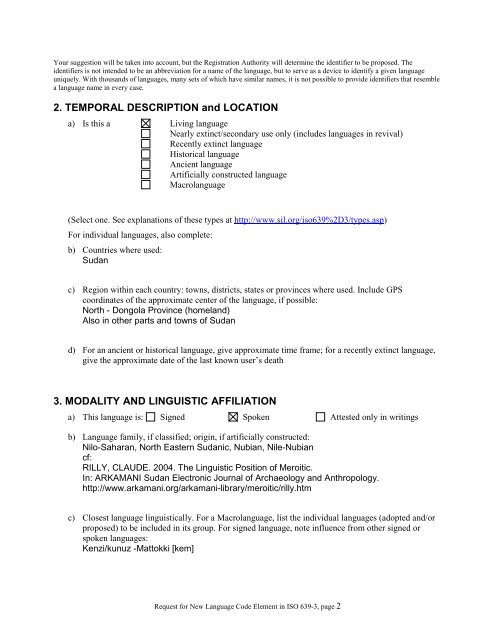ISO 639-3 Registration Authority Request for New ... - SIL International
ISO 639-3 Registration Authority Request for New ... - SIL International
ISO 639-3 Registration Authority Request for New ... - SIL International
You also want an ePaper? Increase the reach of your titles
YUMPU automatically turns print PDFs into web optimized ePapers that Google loves.
Your suggestion will be taken into account, but the <strong>Registration</strong> <strong>Authority</strong> will determine the identifier to be proposed. The<br />
identifiers is not intended to be an abbreviation <strong>for</strong> a name of the language, but to serve as a device to identify a given language<br />
uniquely. With thousands of languages, many sets of which have similar names, it is not possible to provide identifiers that resemble<br />
a language name in every case.<br />
2. TEMPORAL DESCRIPTION and LOCATION<br />
a) Is this a Living language<br />
Nearly extinct/secondary use only (includes languages in revival)<br />
Recently extinct language<br />
Historical language<br />
Ancient language<br />
Artificially constructed language<br />
Macrolanguage<br />
(Select one. See explanations of these types at http://www.sil.org/iso<strong>639</strong>%2D3/types.asp)<br />
For individual languages, also complete:<br />
b) Countries where used:<br />
Sudan<br />
c) Region within each country: towns, districts, states or provinces where used. Include GPS<br />
coordinates of the approximate center of the language, if possible:<br />
North - Dongola Province (homeland)<br />
Also in other parts and towns of Sudan<br />
d) For an ancient or historical language, give approximate time frame; <strong>for</strong> a recently extinct language,<br />
give the approximate date of the last known user’s death<br />
3. MODALITY AND LINGUISTIC AFFILIATION<br />
a) This language is: Signed Spoken Attested only in writings<br />
b) Language family, if classified; origin, if artificially constructed:<br />
Nilo-Saharan, North Eastern Sudanic, Nubian, Nile-Nubian<br />
cf:<br />
RILLY, CLAUDE. 2004. The Linguistic Position of Meroitic.<br />
In: ARKAMANI Sudan Electronic Journal of Archaeology and Anthropology.<br />
http://www.arkamani.org/arkamani-library/meroitic/rilly.htm<br />
c) Closest language linguistically. For a Macrolanguage, list the individual languages (adopted and/or<br />
proposed) to be included in its group. For signed language, note influence from other signed or<br />
spoken languages:<br />
Kenzi/kunuz -Mattokki [kem]<br />
<strong>Request</strong> <strong>for</strong> <strong>New</strong> Language Code Element in <strong>ISO</strong> <strong>639</strong>-3, page 2
















